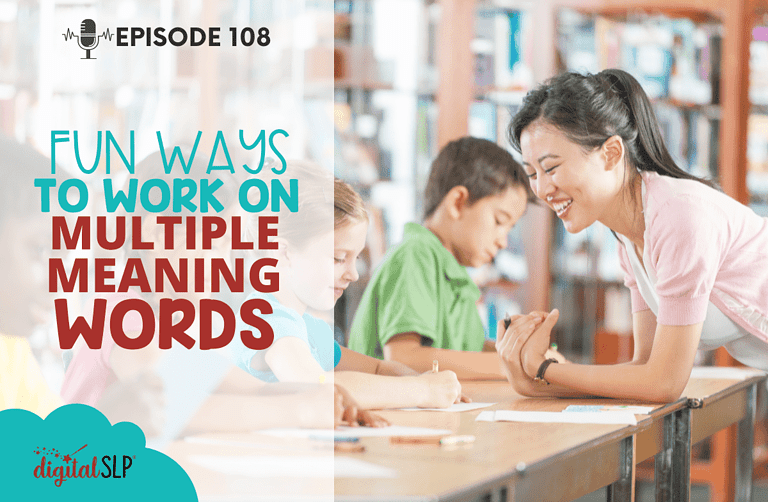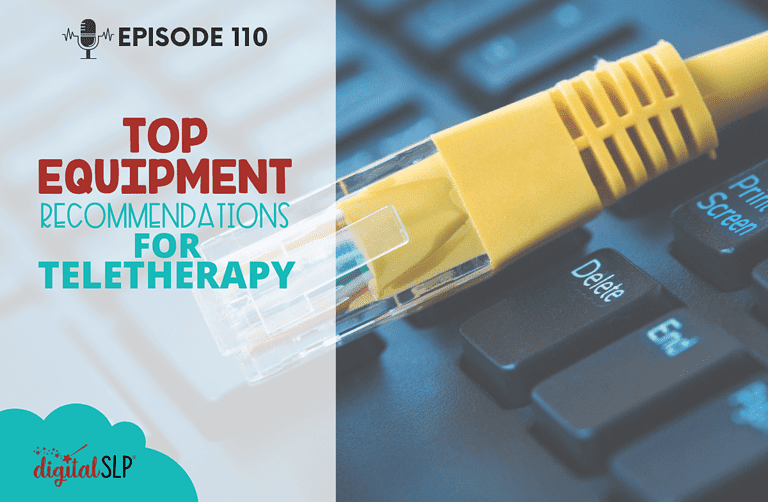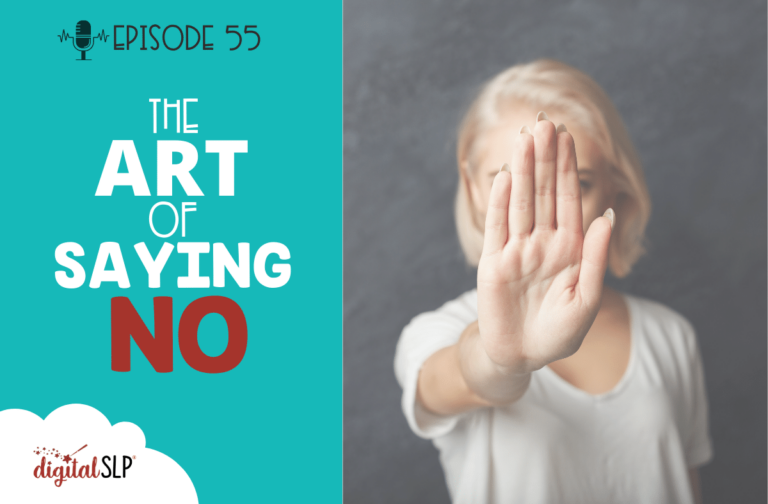This post contains affiliate links for which we may receive compensation at no additional cost to you. Click here to read our full affiliate policy.
We’ve probably all written goals addressing multiple-meaning words at some point in our careers as SLPs. Working with multiple-meaning words is challenging for kids who have language-based learning disabilities, and this is a common area to target in language therapy, especially for our middle school and late-elementary-age students. In this episode, I discuss fun ways to work on multiple-meaning words.
Using Books As Fun Ways to Work on Multiple-Meaning Words
Books such as “Yaks Yak” by Linda Sue Park are great for their engaging illustrations and variety of animal-related examples. These books prompt discussions and build an understanding of context clues, inference, and predictions. Other recommendations include How Much Can a Bare Bear Bear?, If You Were a Homonym or a Homophone, and The Bat Can Bat.
Incorporating Acting and Movements when Teaching Multiple-Meaning Words
In addition to using books to teach multiple meaning words, incorporating acting into sessions can be a fun and engaging way to work with energetic students. Using a list of multiple meaning words, students can take turns acting out one of the possible meanings while others guess the intended meaning. This activity can be lighthearted and silly, but also helps students retain information.
Incidental teaching to reinforce the understanding of multiple meaning words
This involves pretending to misunderstand the word when it’s used, such as with posters, morning announcements, or during games like UNO. The students will correct the misunderstanding and have a discussion about the different meanings of the word. The author suggests keeping a list of common multiple meaning words to be prepared for these situations.
References and Resources:
- Common Core State Standards
- How Much Can a Bare Bear Bear?
- If You Were a Homonym or a Homophone
- McKeown, M. G. (2019). Effective vocabulary instruction fosters knowing words, using words, and understanding how words work. Language, Speech, and Hearing Services in Schools, 50(4), 466–476.
- https://doi.org/10.1044/2019_LSHSS-VOIA-18-0126
- The Bat Can Bat
- What’s the Point? A Book About Multiple Meaning Words
- Yaks Yak
Full Transcript of Podcast: Fun Ways to Work on Multiple Meaning Words
Episode 108 - Fun Ways to Work on Multiple Meaning Words
Hey everyone! Welcome back to another episode of the Speech Space Podcast, which is a podcast full of tips and resources for SLPs. I am your host, Jessica Cassity, and this is Episode 108.
Today, we're going to be talking about fun ways to work on multiple meaning words. Before we jump in, I wanted to mention that this podcast is brought to you by The Digital SLP membership site, which is a site that features time-saving interactive digital resources that are all teletherapy platform-friendly. You can learn more or sign up for a free trial by heading on over to thedigitalslp.com/digitalslp.
We've probably all written goals addressing multiple meaning words at some point during our SLP careers. Working with multiple meaning words is challenging for kids who have language-based learning disabilities, and this is a really common area for us to target in language therapy, especially for our middle school and late-elementary age students. With this in mind, one thing I wanted to share is that in the language section of the Common Core State Standards, students are actually required to be able to determine the meaning of multiple meaning words starting in kindergarten!
Of course, when they are in kindergarten, they are doing this with kindergarten-level texts and developmentally appropriate kindergarten words, but they still need to learn the underlying idea that two words can actually sound exactly the same and have completely different meanings. Then, as students get older, they're expected to determine the meaning of increasingly complex multiple meaning words every year. This shows us that the important skill here is learning strategies that our students can apply to increasingly complex words and texts. It's generally not as helpful for us to drill students on word pairs. This also shows us that we might wanna consider introducing multiple meaning goals earlier than maybe we're used to, possibly even with early elementary age students. Now, of course, every student is different, and you know what the individual needs are for your caseload, so of course keep that in mind.
Let's move into talking about actual treatment strategies for multiple meaning words. Our focus today is finding really fun ways to work with multiple meaning words, but I also want to emphasize the importance of starting off with explicit instruction. Students need to know what they're working on and why they're working on it. We also need to make sure that we are actually teaching a skill before we begin taking data with it. Otherwise, we're just testing our students all the time, without really helping them learn. Depending on the ages of our students and clients, it can also be useful to teach them the technical terms like homonym and homophone rather than always calling them multiple meaning words. This could even lead into a discussion on Greek roots and prefixes and suffixes.
We really want to start finding every opportunity to deepen our students' knowledge of words and show them how words connect to each other. I think that's why I love working on multiple meaning words so much! They are a great way to get students excited about language and help them see how weird and fascinating and powerful words can be. Also, the nature of multiple meaning words is that they invite some gentle confusion and misunderstanding, which can lead to playfulness and humor in our sessions. Ultimately, we can use multiple meaning words to show students that words are fun, so let's talk about some ways to do that.
We can start by bringing in the fun and laughter from the beginning. One of my very favorite ways to introduce the concept of multiple meaning words is by using the wonderful book Yaks Yak by Linda Sue Park. This book is fantastic because the illustrations really make it appropriate for almost any age level. It's simple enough to engage your young learners and hilarious enough that older kids won't find this to be babyish or insulting. The book includes a big collection of multiple meaning word pairs involving animals like "rams ram," "cranes crane," "bats bat," and "slugs slug." So for each word pair, there's a page that has a silly illustration with the two words, and then when you turn the page, the verb from the word pair is defined, and there's another funny illustration that provides additional details. This format gives you the option to introduce the concept of multiple meaning words in a really engaging way.
You could show the student one of the pictures - let's use the one where there are pigs holding onto huge piles of apples, as an example. So you could say, "Okay, in this picture, hogs hog! We know that hog is another word for pig, and the word hog can also be used to describe what these hogs are doing. Hmmm, what do you think that the other meaning of the word hog might be? Let's see if we can figure it out." In the resulting discussion, you could ask the students to explain their thought process and identify clues from the picture that help them. This way, you are laying the groundwork for the importance of looking at context clues. You're also bringing in inferences and predictions, and you could even tie in a discussion of nouns and verbs. After you go through several examples with significant support, you could progress through the rest of the book and use the remaining examples to start to build independence and really establish the concept.
If you prefer a book that includes additional specific teaching, there are some other great options out there, and I will make sure that I link all of these in the show notes. Some of my favorites are: If You Were a Homonym or a Homophone by Nancy Lowen and Sarah Jean Gray, How Much Can a Bare Bear Bear? By Brian P. Cleary, What's the Point? A Book About Multiple Meaning Words by Josephine A. Fowler, and The Bat Can Bat by Gene Barretta. And like I said, I will make sure to provide links to those in the show notes, so don't worry about writing those down. All of these books vary slightly in their illustration style and overall feel.
The Bat Can Bat is especially good if you want to focus on words that sound the same and are spelled the same. Not only do books work well to introduce multiple meaning words, but they're also great for deepening students understanding in a fun way. Whenever we're working with any type of vocabulary instruction, it's important to use words in context as much as possible. The good news is you don't need any special specific books for this! You can use the books that you already have, ideally engaging ones that you already know that your students or clients enjoy.
You can do some quick prep ahead of time and find a few potential multiple meaning words on each page, and then jot them down on a post-it or on a computer document. Some books have more options than others, so it definitely does help to make sure that you check ahead of time. As you read through the books together. When you get to one of the multiple meaning words, you can point it out and then support the students in identifying the possible meanings and using context clues to figure out the intended meaning. This can be very lighthearted - you can talk about how the story would change if the author actually meant to use the other possible meaning, and laugh about how silly that would be.
Using books really can be one of the most fun and versatile ways to work on multiple meaning words, but our students who need more movement during their sessions might enjoy some additional options as well. For these energetic students in particular, I love to incorporate some acting. Now, this doesn't require much prep time and students really get into it, so all you need to do is grab a list of multiple meaning words, either from a Google search, say Teachers Pay Teachers, or even a subscription service like The Digital SLP. And then you're going to cut out the words, and take turns giving a student a word and discussing all the potential meanings together. Then the student chooses one of the possible meanings and acts it out, and either you or the other students in the group, guess what the intended meaning was. It's okay if this gets pretty silly. If the students are laughing and engaged, then they are much more likely to retain the information.
Speaking of silliness, there's just one more therapy idea I want to share, and it's a really fun one. Once your students and clients develop an understanding of multiple meaning words, you can continue to review the concept through some incidental teaching. To do this, when a student uses a multiple meaning word or you encounter one in your therapy materials during a session, you can pretend to misunderstand. You could even do this with posters in the hall as you walk with your students to your sessions, or you could do this with morning announcements that come over the loudspeaker.
I even love to do this with games. For example, in the game Uno, there's a card that indicates "skip." Of course, it means to skip a turn, but when this card is played, you could get up and skip around the room - and, of course, then have a discussion afterward about the word and all the potential meanings that it has. Students tend to love when they have a chance to catch you making a mistake and they get an opportunity to teach you something. This type of incidental teaching does require some thinking on your feet, but I think most of us SLPs are used to that since we do it all day long. You can also keep a list of common multiple meaning words handy and just brainstorm some situations when they might come up so you feel ready.
I hope this episode inspired you to try some new, fun therapy strategies for teaching multiple meaning words! Before we close, I just wanted to emphasize that in all of these ideas, the most important component is the discussion with the students about the words, how the words work and relate to each other, and how to figure out their intended meanings. When we engage students in these discussions by using fun activities, we help to build their metalinguistic awareness, which is their ability to think and talk about language. This will support their academic growth in so many ways, and we can definitely have fun while doing it.
If you've enjoyed today's episode, I would be so grateful if you would take a moment to leave a five-star review to make it easier for fellow SLPs to find this show. We put out new episodes twice a month on the first and third Tuesdays. Also, please don't forget to check out thedigitalslp.com/digitalslp if you are interested in exploring a free trial membership and other content. Thanks so much for listening!













Recent Comments